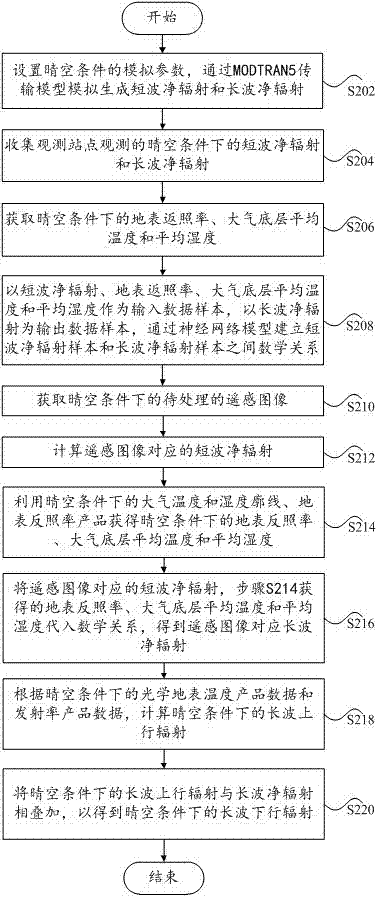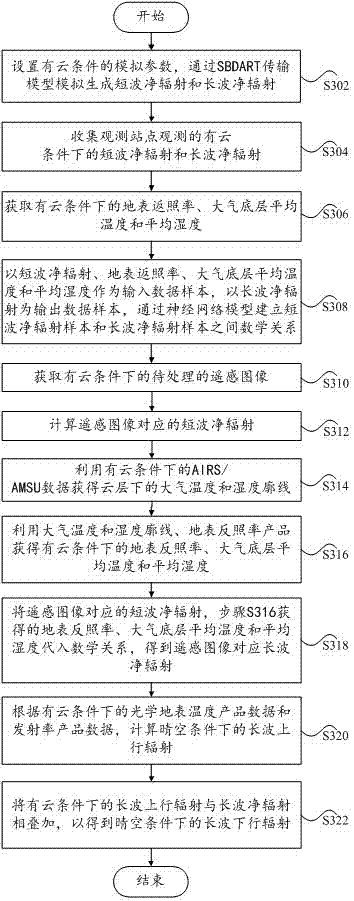Method and device for estimating longwave net radiation and downlink radiation using shortwave radiation
A technology of long-wave downstream radiation and long-wave net radiation, which is applied in the field of remote sensing and can solve the problems of spatial discontinuity of radiation products
- Summary
- Abstract
- Description
- Claims
- Application Information
AI Technical Summary
Problems solved by technology
Method used
Image
Examples
Embodiment 1
[0035] Embodiment 1 of the present invention provides a method for estimating long-wave downlink radiation by using short-wave radiation, such as figure 1 As shown, the method includes the following steps S102 to S112.
[0036] Step S102: Obtain short-wave net radiation samples and long-wave net radiation samples.
[0037] Specifically, when acquiring sample data, a radiation transfer model may be used for simulation to generate short-wave net radiation data and long-wave net radiation data as short-wave net radiation samples and long-wave net radiation samples, respectively.
[0038] For example, taking the radiative transfer model as MODTRAN5 as an example, set different atmospheric temperature / humidity profiles, aerosol types, horizontal meteorological sight distances, surface albedo\emissivity, surface temperature, cloud types, cloud heights, cloud A series of parameters such as water content, solar zenith angle, observation zenith angle, and relative azimuth angle are si...
Embodiment 2
[0059] Embodiment 2 of the present invention provides a method for estimating long-wave downlink radiation by using short-wave radiation. In this method, clear-sky conditions are taken as the premise, such as figure 2 As shown, the method includes the following steps S202 to S220.
[0060] Step S202: Set simulation parameters for clear sky conditions, and generate short-wave net radiation and long-wave net radiation through MODTRAN5 transmission model simulation.
[0061] Step S204: Collect short-wave net radiation and long-wave net radiation under clear-sky conditions observed by the observation site.
[0062] Step S206: Obtain the surface albedo, the average temperature and the average humidity at the bottom of the atmosphere under clear sky conditions.
[0063] Step S208: Taking short-wave net radiation, surface albedo, average temperature and average humidity at the bottom of the atmosphere as input data samples, and long-wave net radiation as output data samples, establ...
Embodiment 3
[0072] Embodiment 3 of the present invention provides a method for estimating long-wave downlink radiation by using short-wave radiation. In this method, cloudy conditions are taken as the premise, such as image 3 As shown, the method includes the following steps S302 to S322.
[0073] Step S302: Set simulation parameters with cloud conditions, and generate short-wave net radiation and long-wave net radiation through SBDART transmission model simulation.
[0074] Step S304: Collect short-wave net radiation and long-wave net radiation observed at the observation site under cloudy conditions.
[0075] Step S306: Obtain the surface albedo, the average temperature and the average humidity at the bottom of the atmosphere under cloudy conditions.
[0076] Step S308: Taking short-wave net radiation, surface albedo, average temperature and average humidity at the bottom of the atmosphere as input data samples, and long-wave net radiation as output data samples, establish the relatio...
PUM
 Login to View More
Login to View More Abstract
Description
Claims
Application Information
 Login to View More
Login to View More - R&D
- Intellectual Property
- Life Sciences
- Materials
- Tech Scout
- Unparalleled Data Quality
- Higher Quality Content
- 60% Fewer Hallucinations
Browse by: Latest US Patents, China's latest patents, Technical Efficacy Thesaurus, Application Domain, Technology Topic, Popular Technical Reports.
© 2025 PatSnap. All rights reserved.Legal|Privacy policy|Modern Slavery Act Transparency Statement|Sitemap|About US| Contact US: help@patsnap.com



